Estimation of Phytoplankton Responses to Hurricane Gonu over the Arabian Sea Based on Ocean Color Data
Abstract
:1. Introduction
2. Data and Methodology
2.1. Satellite Products and Hurricane Data
2.2. Hydrographic Data
2.3 Methodology
Sea Surface Wind Vectors (SSWVs)
Ekman Pumping Velocity (EPV)
Mixed Layer Depth (MLD)
Chl-a Concentrations
Time Series of Satellite Data
3. Results
3.1. Hurricane Gonu Viewed by QuikSCAT Sensor
3.2. Oceanic Responses
SST
EPV
Vertical Profiles of Temperature and Salinity
Phytoplankton and TSS
4. Discussions
4.1. Overall Increase of Phytoplankton in the Arabian Sea
4.2. Different Intensities of the Two Chl-a Blooms
5. Summary
Acknowledgments
References and Notes
- Chang, J.; Chung, C.C.; Gong, G.C. Influences of cyclones on chlorophyll-a concentration and Synechococcus abundance in a subtropical western Pacific coastal ecosystem. Mar. Ecol. Prog. Ser. 1996, 140, 199–205. [Google Scholar]
- Lin, I.I; Liu, W.T.; Wu, C.; Wong, G.T.F.; Hu, C.; Chen, Z.; Liang, W.; Yang, Y.; Liu, K. New evidence for enhanced ocean primary production triggered by tropical cyclone. Geophys. Res. Lett. 2003, 30, 1718–1721. [Google Scholar] [CrossRef]
- Shi, W.; Wang, M. Observations of a Hurricane Katrina-induced phytoplankton bloom in the Gulf of Mexico. Geophys. Res. Lett. 2007, 34, L11607. [Google Scholar] [CrossRef]
- Zheng, G.M.; Tang, D.L. Offshore and nearshore chlorophyll increases induced by typhoon and typhoon rain. Mar. Ecol. Prog. Ser. 2007, 333, 61–74. [Google Scholar]
- Prasad, T.G.; Hogan, P.J. Upper-ocean response to Hurricane Ivan in a 1/25 degrees nested Gulf of Mexico HYCOM. J. Geophys. Res. 2007, 112. [Google Scholar] [CrossRef]
- Subrahmanyam, B.; Murty, V.S.N.; Sharp, R.J.; O'Brien, J.J. Air-sea coupling during the tropical cyclones in the Indian Ocean: a case study using satellite observations. Pure Appl. Geophys. 2005, 162, 1643–1672. [Google Scholar] [CrossRef]
- Babin, S.M.; Carton, J.A.; Dickey, T.D.; Wiggert, J.D. Satellite evidence of hurricane-induced phytoplankton blooms in an oceanic desert. J. Geophys. Res. 2004, 109, C03043. [Google Scholar] [CrossRef]
- Fischer, J.; Schott, F.; Stramma, L. Currents and transports of the Great Whirl Socotra Gyre system during the summer monsoon, August 1993. J. Geophys. Res. 1996, 101, 3573–3587. [Google Scholar]
- Lee, C.M.; Jones, B.H.; Brink, K.H.; Fischer, A.S. The upper-ocean response to monsoonal forcing in the Arabian Sea: seasonal and spatial variability. Deep-Sea Res. II 2000, 47, 1177–1226. [Google Scholar]
- Latasa, M.; Bidigare, R.R. A comparison of phytoplankton populations of the Arabian Sea during the Spring Intermonsoon and Southwest Monsoon of 1995 as described by HPLC-analyzed pigments. Deep-Sea Res. II 1998, 45, 2133–2170. [Google Scholar]
- Fischer, A.S.; Weller, R.A.; Rudnick, D.L.; Eriksen, C.C.; Lee, C.M.; Brink, K.H.; Fox, C.A.; Leben, R.R. Mesoscale eddies, coastal upwelling, and the upper-ocean heat budget in the Arabian Sea. Deep-Sea Res. II 2002, 49, 2231–2264. [Google Scholar]
- Bartolacci, D.M.; Luther, M.E. Patterns of co-variability between physical and biological parameters in the Arabian Sea. Deep-Sea Res. II 1999, 46, 1933–1964. [Google Scholar]
- Wiggert, J.D.; Murtugudde, R.G.; McClain, C.R. Processes controlling interannual variations in wintertime (Northeast Monsoon) primary productivity in the central Arabian Sea. Deep-Sea Res. II 2002, 49, 2319–2343. [Google Scholar]
- Madhupratap, M.; Kumar, S.P.; Bhattathiri, P.M.A.; Kumar, M.D.; Raghukumar, S.K.; Nair, K.C.; Ramaiah, N. Mechanism of the biological response to winter cooling in the northeastern Arabian Sea. Nature 1996, 384, 549–552. [Google Scholar]
- Brock, J.C.; McClain, C.R.; Anderson, D.M.; Prell, W.L.; Hay, W.W. Southwest monsoon circulation and environments of recent planktonic foraminifera in the northwestern Arabian Sea. Palaeogeogr 1992, 7, 799–813. [Google Scholar]
- Ittekkot, V.; Haake, B.; Bartsch, M.; Nair, R.R.; Ramaswamy, V. Upwelling Systems: Evolution since the Early Miocene; Summerhayes, C.P.E., Ed.; Geological Society Publication: London, 1992; Volume 64, pp. 167–176. [Google Scholar]
- Van-Couwelaar, M. Zooplankton and microplankton biomass off Somalia and in the southern Red Sea during the SW monsoon of 1992 and the NE monsoon of 1993. Deep-Sea Res. II 1997, 44, 1213–1234. [Google Scholar]
- Conan, S.M.-H.; Brummer, G.-J.A. Fluxes of planktonic foraminifera in response to monsoonal upwelling on the Somalia Basin margin. Deep-Sea Res. II 2000, 47, 2207–2227. [Google Scholar]
- Marra, J.; Barber, R.T. Primary productivity in the Arabian Sea: A synthesis of JGOFS data. Prog. Oceanogr. 2005, 65, 159–175. [Google Scholar]
- Banse, K. Seasonality of phytoplankton chlorophyll in the central and northern Arabian Sea. Deep-Sea Res. 1987, 34, 713–723. [Google Scholar]
- Barber, R.T.; Marra, J.; Bidigare, R.C.; Codispoti, L.A.; Halpern, D.; Johnson, Z.; Latasa, M.; Goericke, R.; Smith, S.L. Primary productivity and its regulation in the Arabian Sea during 1995. Deep-Sea Res. II 2001, 48, 1127–1172. [Google Scholar]
- Ryther, J.H.; Menzel, D. W. On the production, composition, and distribution of organic matter in the western Arabian Sea. Deep-Sea Res. I 1965, 12, 199–209. [Google Scholar]
- Banzon, V.F.; Evans, R.E.; Gordon, H.R.; Chomko, R.M. SeaWiFS observations of the Arabian Sea southwest monsoon bloom for the year 2000. Deep-Sea Res. II 2004, 51, 189–208. [Google Scholar]
- Smith, S.L.; Madhupratap, M. Mesozooplankton of the Arabian Sea: Patterns influenced by seasons, upwelling, and oxygen concentrations. Prog. Oceanogr. 2005, 65, 214–239. [Google Scholar]
- Subrahmanyam, B.; Rao, K.H.; Rao, N.S.V.; Murty, S.N.; Sharp, R.J. Influence of a tropical cyclone on chlorophyll-a concentration in the Arabian Sea. Geophys. Res. Lett. 2002, 29(22), 2065. [Google Scholar] [CrossRef]
- Zhao, H.; Tang, D.L. Effect of 1998 El Nino on the distribution of phytoplankton in the South China Sea. J. Geophys. Res. 2007, 112, 1–8, C02017. [Google Scholar] [CrossRef]
- Wentz, F.J.; Gentemann, C.; Smith, D.; Chelton, D. Satellite measurements of sea surface temperature through clouds. Science 2000, 288, 847–850. [Google Scholar]
- Liu, W.T.; Xie, X.; Polito, P.S.; Xie, S.P.; Hashizume, H. Atmospheric manifestation of tropical instability waves observed by QuikSCAT and Tropical Rain Measuring Mission. Geophys. Res. Lett. 2000, 27, 2545–2548. [Google Scholar]
- Behrenfeld, M.J.; Falkowski, P.G. Photosynthetic rates derived from satellite-based chlorophyll concentration. Limnol. Oceanogr. 1997, 42, 1–20. [Google Scholar]
- Schott, F.; McCreary, J.P. The monsoon circulation of the Indian Ocean. Prog. Oceanogr. 2001, 51, 1–123. [Google Scholar]
- Pan, D.L; Haung, H.Q.; Mao, T.M.; Mao, Z.H. Ocean color remote sensing by Sea WIFS in China. Proceedings 1999 Asian Conference of Remote Sensing. 1999. Available online: http://www.gisdevelopment.net/aars/acrs/1999/ts8/ts8348.asp.
- Conkright, M.E.; Levitus, S.; Antonov, J.I.; Baranova, O.; Boyer, T.P.; Garcia, H.E.; Gelfeld, R.; Johnson, D.; Locarnini, R.A.; O'Brien, T.D.; Smolyar, I.; Stephens, C. World Ocean Database 2001; Levitus, S., Ed.; National Oceanic and Atmos Admin: Silver Spring, MD, 2002; Volume 1, p. 167. [Google Scholar]
- Stewart, R.H. Introduction to Physical Oceanography; Stewart, R. H., Ed.; Dept. of Oceanography, Texas A & M University: College Station: TX, 2002. available online: http://oceanworld.tamu.edu/resources/ocng_textbook/contents.html.
- Kara, A.B.; Rochford, P.A.; Hurlburt, H.E. An optimal definition for ocean mixed layer depth. Geophys. Res. Lett. 2000, 105, 16:803–16:821. [Google Scholar]
- Cavender-Baresa, K.K; Karlb, D.M.; Chisholma, S.W. Nutrient gradients in the western North Atlantic Ocean: Relationship to microbial community structure and comparison to patterns in the Pacific Ocean. Deep-Sea Res. I 2001, 48, 2373–2395. [Google Scholar]
- Nozaki, Y.; Alibo, D.S. Importance of vertical geochemical processes in controlling the oceanic profiles of dissolved rare earth elements in the northeastern Indian Ocean. Earth Planet. Sci. Lett. 2003, 205, 155–172. [Google Scholar]
- Behrenfeld, M.J.; O'Malley, R.T.; Siegel, D.A.; McClain, C.R.; Sarmiento, J.L.; Feldman, G.C.; Milligan, A.J.; Falkowski, P.G.; Letelier, R.M.; Boss, E.S. Climate-driven trends in contemporary ocean productivity. Nature 2006, 444, 752–755. [Google Scholar] [CrossRef]
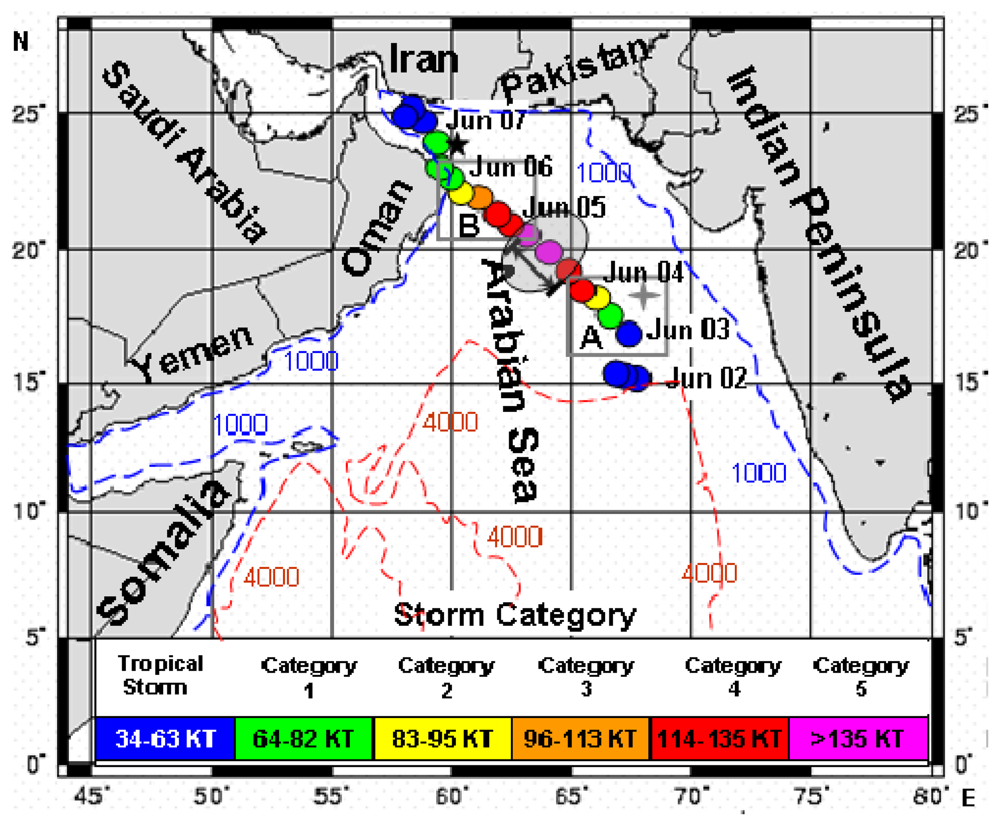

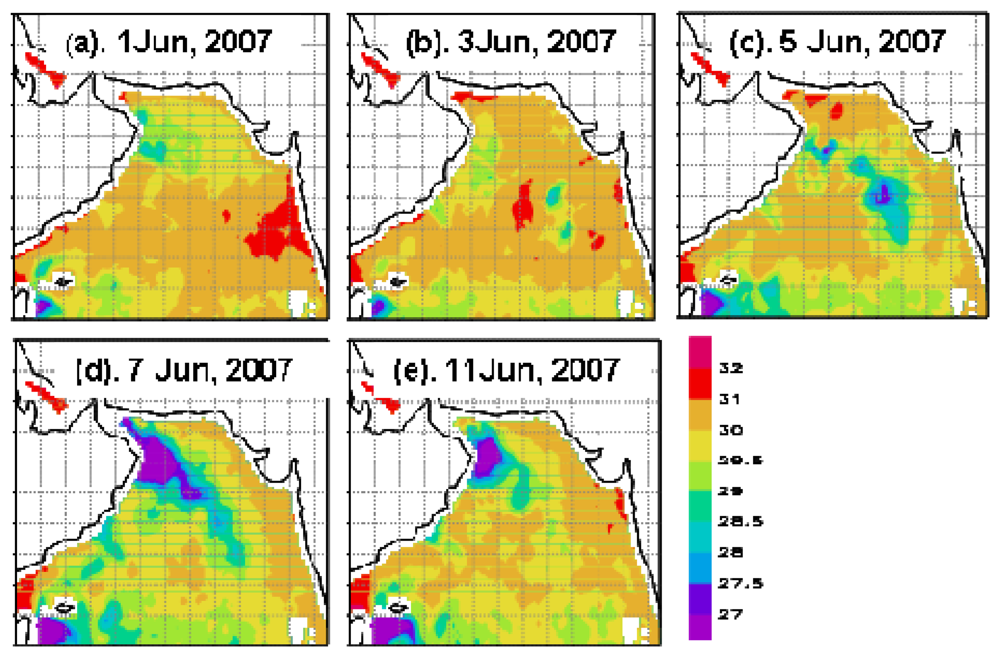
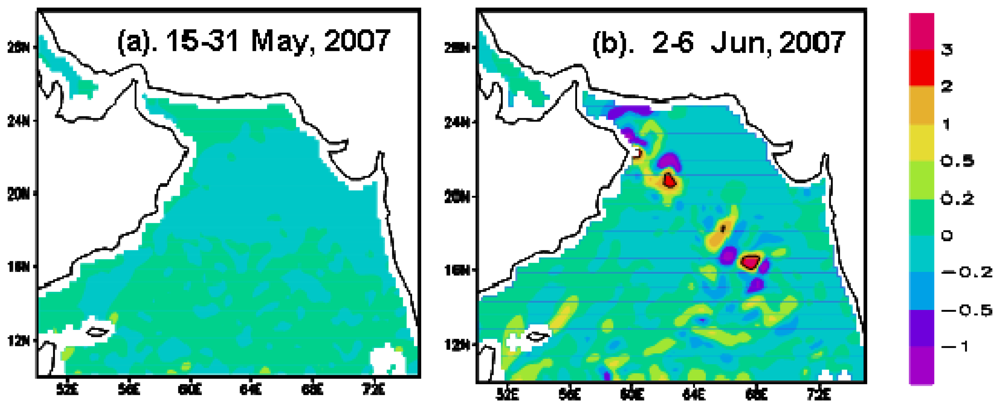
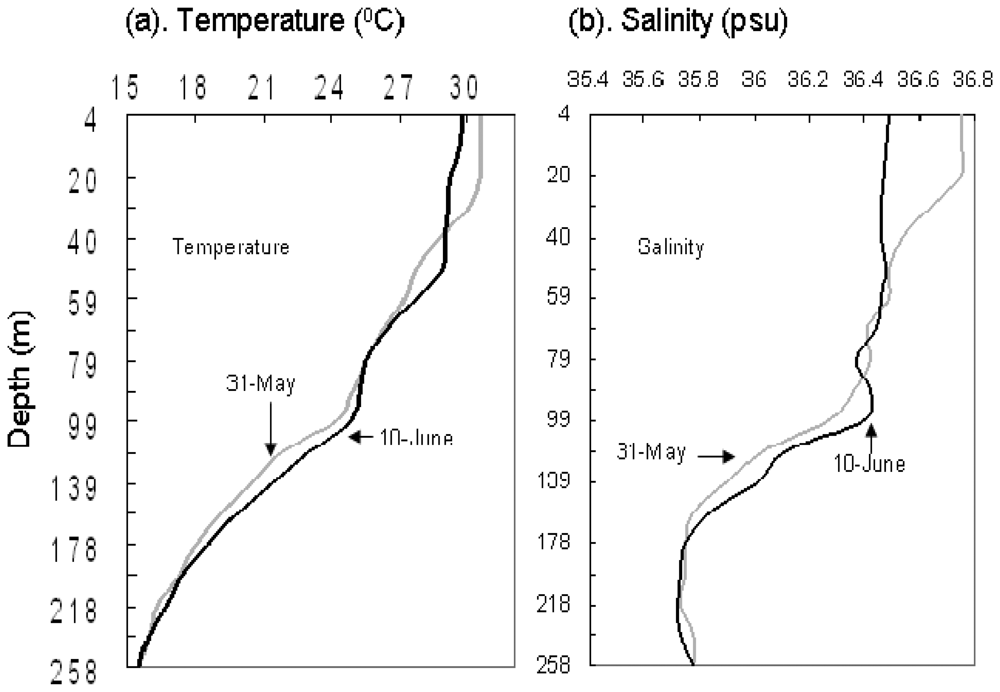
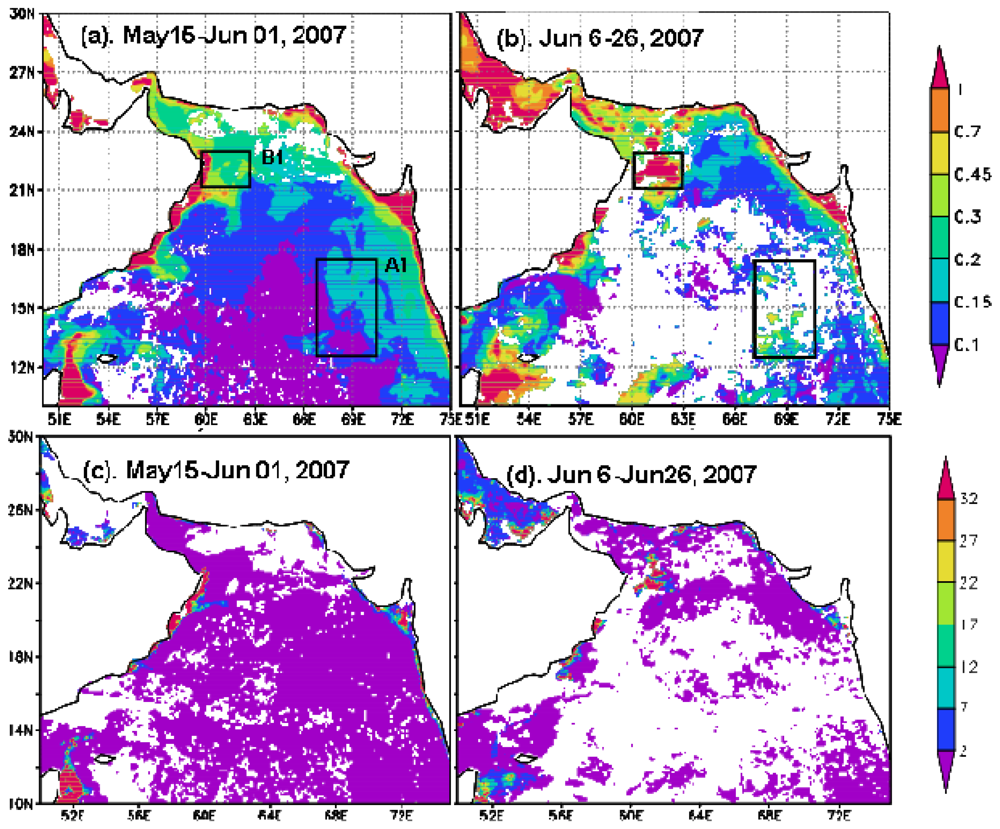
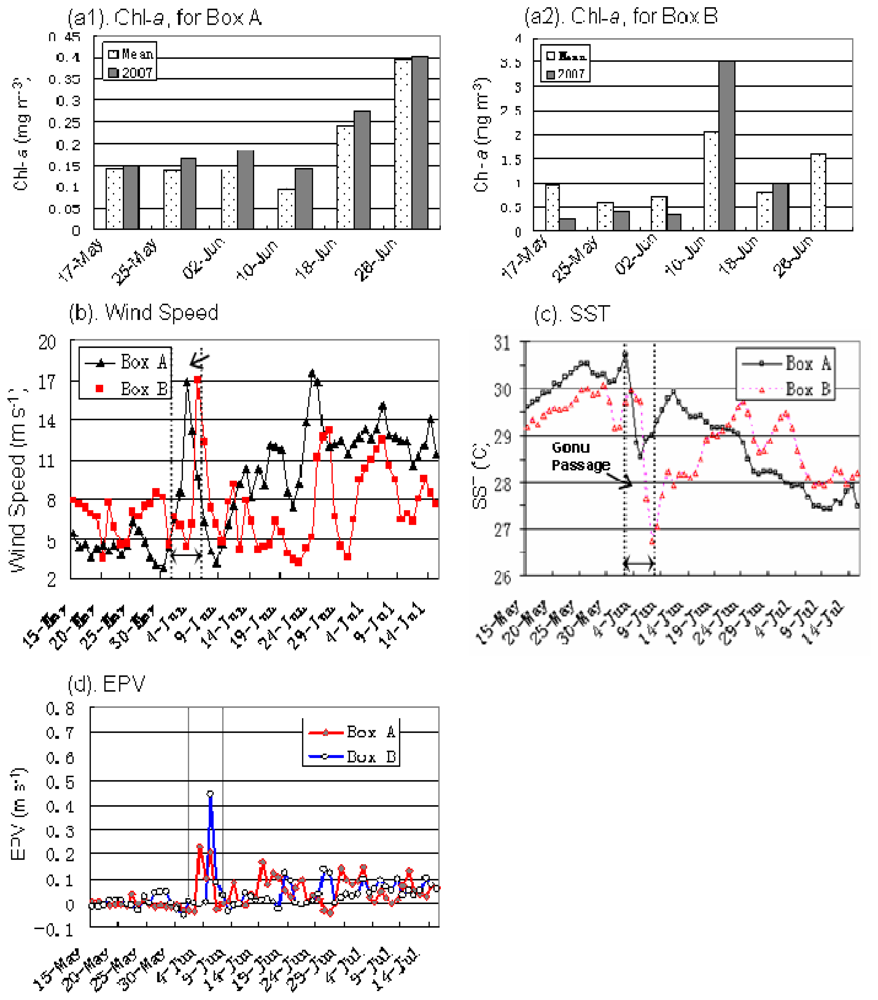
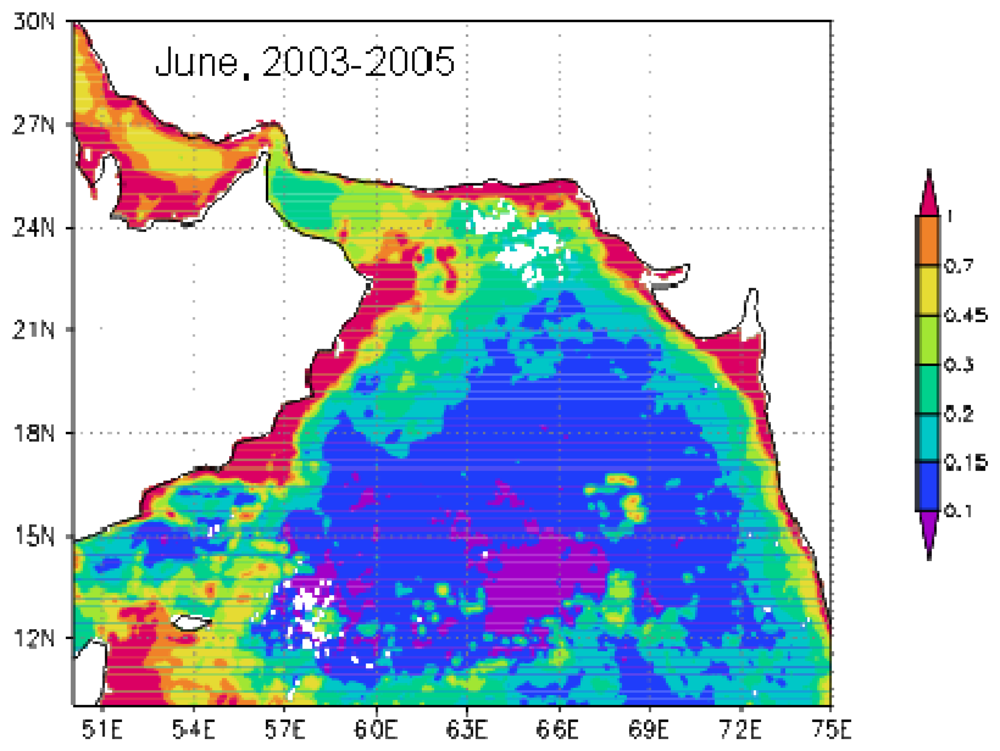
| Parameter | The whole passage | Box A | Box B |
|---|---|---|---|
| Mean moving speed* | 3.9 | 3.4 | 3.2 |
| Range of moving speed* | 2.1-4.9 | 2.7-4.4 | 2. 2-3.8 |
| MSW | 72 | 67 | 72 |
| Mean MSW | 61 | 55 | 56 |
© 2008 by the authors; licensee Molecular Diversity Preservation International, Basel, Switzerland. This article is an open-access article distributed under the terms and conditions of the Creative Commons Attribution license ( http://creativecommons.org/licenses/by/3.0/).
Share and Cite
Wang, D.; Zhao, H. Estimation of Phytoplankton Responses to Hurricane Gonu over the Arabian Sea Based on Ocean Color Data. Sensors 2008, 8, 4878-4893. https://doi.org/10.3390/s8084878
Wang D, Zhao H. Estimation of Phytoplankton Responses to Hurricane Gonu over the Arabian Sea Based on Ocean Color Data. Sensors. 2008; 8(8):4878-4893. https://doi.org/10.3390/s8084878
Chicago/Turabian StyleWang, Dongxiao, and Hui Zhao. 2008. "Estimation of Phytoplankton Responses to Hurricane Gonu over the Arabian Sea Based on Ocean Color Data" Sensors 8, no. 8: 4878-4893. https://doi.org/10.3390/s8084878




